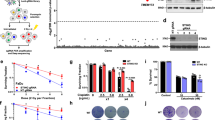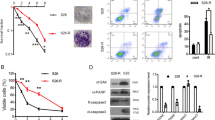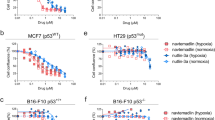Abstract
Cancer gene therapy that utilizes toxic transgene products requires strict transcriptional targeting to prevent adverse normal tissue effects. We report on the use of a promoter derived from the cyclin dependent kinase inhibitor, p21(WAF1), to control transgene expression. We demonstrate that this promoter is relatively silent in normal cells (L132, FSK, HMEC-1) compared to the almost constitutive expression obtained in tumour cells (DU145, LNCaP, HT29 and MCF-7) of varying p53 status, a characteristic that will be important in gene therapy protocols. In addition, we found that the p21(WAF1) promoter could be further induced by both external beam radiation (up to eight-fold in DU145 cells), intracellular-concentrated radionuclides ([211At]MABG) (up to 3.5-fold in SK-N-BE(2c) cells) and hypoxia (up to four-fold in DU145 cells). We have previously achieved significant radiosensitization of tumour cells both in vitro and in vivo by using inducible nitric oxide synthase (iNOS) gene therapy to generate the potent radiosensitizer, nitric oxide (NO•). Here, we report that a clinically relevant schedule of p21(WAF1)-driven iNOS gene therapy significantly sensitized both p53 wild-type RIF-1 tumours and p53 mutant HT29 tumours to fractionated radiotherapy. Our data highlight the utility of this p21(WAF1)/iNOS-targeted approach.
This is a preview of subscription content, access via your institution
Access options
Subscribe to this journal
Receive 12 print issues and online access
$259.00 per year
only $21.58 per issue
Buy this article
- Purchase on Springer Link
- Instant access to full article PDF
Prices may be subject to local taxes which are calculated during checkout





Similar content being viewed by others
References
Robson T, Hirst DG . Transcriptional targeting in cancer gene therapy. J Biomed Biotechnol 2003; 2: 110–137.
Weichselbaum RR, Kufe DW, Advani SJ, Roizman B . Molecular targeting of gene therapy and radiotherapy. Acta Oncol 2001; 40: 735–738.
Kufe D, Weichselbaum R . Radiation therapy: activation for gene transcription and the development of genetic radiotherapy–therapeutic strategies in oncology. Cancer Biol Ther 2003; 2: 326–329.
Lopez CA, Kimchi ET, Mauceri HJ, Park JO, Mehta N, Murphy KT et al. Chemoinducible gene therapy: a strategy to enhance doxorubicin antitumour activity. Mol Cancer Ther 2004; 3: 1167–1175.
Senzer N, Mani S, Rosemurgy A, Nemunaitis J, Cunningham C, Guha C et al. TNFerade biologic, an adenovector with a radiation-inducible promoter, carrying the human tumour necrosis factor alpha gene: a phase I study in patients with solid tumours. J Clin Oncol 2004; 22: 592–601.
Mundt AJ, Vijayakumar S, Nemunaitis J, Sandler A, Schwartz H, Hanna N et al. A phase I trial of TNFerade biologic in patients with soft tissue sarcoma in the extremities. Clin Cancer Res 2004; 10: 5747–5753.
Worthington J, Robson T, Scott S, Hirst D . Evaluation of a synthetic CArG promoter for nitric oxide synthase gene therapy of cancer. Gene Therapy 2005; 12: 1417–1423.
Bussink J, Kaanders JH, van der Kogel AJ . Tumour hypoxia at the micro-regional level: clinical relevance and predictive value of exogenous and endogenous hypoxic cell markers. Radiother Oncol 2003; 67: 3–15.
Binley K, Kan O, White J, Naylor S . Exploiting the hypoxia response. Curr Opin Mol Ther 2003; 5: 650–656.
Cowen RL, Williams KJ, Chinje EC, Jaffar M, Sheppard FC, Telfer BA et al. Hypoxia targeted gene therapy to increase the efficacy of tirapazamine as an adjuvant to radiotherapy: reversing tumour radioresistance and effecting cure. Cancer Res 2004; 64: 1396–1402.
Greco O, Dachs GU, Tozer GM, Kanthou C . Mechanisms of cytotoxicity induced by horseradish peroxidase/indole-3-acetic acid gene therapy. J Cell Biochem 2002; 87: 221–232.
Salloum RM, Saunders MP, Mauceri HJ, Hanna NN, Gorski DH, Posner MC et al. Dual induction of the epo-egr-TNF-alpha-plasmid in hypoxic human colon adenocarcinoma produces tumour growth delay. Am Surg 2003; 69: 24–27.
Boulaire J, Fotedar A, Fotedar R . The functions of the cdk-cyclin kinase inhibitor p21WAF1. Pathol Biol (Paris) 2000; 48: 190–202.
Bloom J, Amador V, Bartolini F, DeMartino G, Pagano M . Proteasome-mediated degradation of p21 via N-terminal ubiquitinylation. Cell 2003; 115: 71–82.
el-Deiry WS, Tokino T, Velculescu VE, Levy DB, Parsons R, Trent JM et al. WAF1, a potential mediator of p53 tumour suppression. Cell 1993; 75: 817–825.
Gartel AL, Tyner AL . Transcriptional regulation of the p21((WAF1/CIP1)) gene. Exp Cell Res 1999; 246: 280–289.
Worthington J, Robson T, Murray M, O'Rourke M, Keilty G, Hirst DG . Modification of vascular tone using iNOS under the control of a radiation-inducible promoter. Gene Therapy 2000; 7: 1126–1131.
Worthington J, Robson T, O'Keeffe M, Hirst DG . Tumour cell radiosensitization using constitutive (CMV) and radiation inducible (WAF1) promoters to drive the iNOS gene: a novel suicide gene therapy. Gene Therapy 2002; 9: 263–269.
Worthington J, McCarthy HO, Barrett E, Adams C, Robson T, Hirst DG . Use of the radiation-inducible WAF1 promoter to drive iNOS gene therapy as a novel anti-cancer treatment. J Gene Med 2004; 6: 673–680.
Boyd M, Mairs RJ, Keith WN, Ross SC, Welsh P, Akabani G et al. An efficient targeted radiotherapy/gene therapy strategy utilising human telomerase promoters and radioastatine and harnessing radiation-mediated bystander effects. J Gene Med 2004; 6: 937–947.
Robson T, Worthington J, McKeown SR, Hirst DG . Radiogenic therapy: novel approaches for enhancing tumour radiosensitivity. Technol Cancer Res Treat 2005; 4: 343–361.
Scott SD, Greco O . Radiation and hypoxia inducible gene therapy systems. Cancer Metastasis Rev 2004; 23: 269–276.
Brown JM, Giaccia AJ . The unique physiology of solid tumours: opportunities (and problems) for cancer therapy. Cancer Res 1998; 58: 1408–1416.
Akashi M, Hachiya M, Osawa Y, Spirin K, Suzuki G, Koeffler HP . Irradiation induces WAF1 expression through a p53-independent pathway in KG-1 cells. J Biol Chem 1995; 270: 19181–19187.
Wouters BG, Denko NC, Giaccia AJ, Brown JM . A p53 and apoptotic independent role for p21waf1 in tumour response to radiation therapy. Oncogene 1999; 18: 6540–6545.
Koshiji M, Kageyama Y, Pete EA, Horikawa I, Barrett JC, Huang LE . HIF-1alpha induces cell cycle arrest by functionally counteracting myc. EMBO J 2004; 23: 1949–1956.
Koshiji M, Huang LE . Dynamic balancing of the dual nature of HIF-1alpha for cell survival. Cell Cycle 2004; 3: 853–854.
Goda N, Ryan HE, Khadivi B, McNulty W, Rickert RC, Johnson RS . Hypoxia-inducible factor 1alpha is essential for cell cycle arrest during hypoxia. Mol Cell Biol 2003; 23: 359–369.
Salnikow K, Costa M, Figg WD, Blagosklonny MV . Hyperinducibility of hypoxia-responsive genes without p53/p21-dependent checkpoint in aggressive prostate cancer. Cancer Res 2000; 60: 5630–5634.
Scherr DS, Vaughan Jr ED, Wei J, Chung M, Felsen D, Allbright R et al. BCL-2 and p53 expression in clinically localized prostate cancer predicts response to external beam radiotherapy. J Urol 1999; 162: 12–16; discussion 16–17.
Bristow RG, Brail L, Jang A, Peacock J, Chung S, Benchimol S et al. P53-mediated radioresistance does not correlate with metastatic potential in tumourigenic rat embryo cell lines following oncogene transfection. Int J Radiat Oncol Biol Phys 1996; 34: 341–355.
Yook JI, Kim J . Expression of p21WAF1/CIP1 is unrelated to p53 tumour suppressor gene status in oral squamous cell carcinomas. Oral Oncol 1998; 34: 198–203.
Codegoni AM, Nicoletti MI, Buraggi G, Valoti G, Giavazzi R, D'Incalci M et al. Molecular characterisation of a panel of human ovarian carcinoma xenografts. Eur J Cancer 1998; 34: 1432–1438.
McBride SR, Leonard N, Reynolds NJ . Loss of p21(WAF1) compartmentalisation in sebaceous carcinoma compared with sebaceous hyperplasia and sebaceous adenoma. J Clin Pathol 2002; 55: 763–766.
el-Deiry WS, Tokino T, Waldman T, Oliner JD, Velculescu VE, Burrell M et al. Topological control of p21WAF1/CIP1 expression in normal and neoplastic tissues. Cancer Res 1995; 55: 2910–2919.
Heliez C, Baricault L, Barboule N, Valette A . Paclitaxel increases p21 synthesis and accumulation of its AKT-phosphorylated form in the cytoplasm of cancer cells. Oncogene 2003; 22: 3260–3268.
Asada M, Yamada T, Ichijo H, Delia D, Miyazono K, Fukumuro K et al. Apoptosis inhibitory activity of cytoplasmic p21(Cip1/WAF1) in monocytic differentiation. EMBO J 1999; 18: 1223–1234.
Dong Y, Zhang H, Hawthorn L, Ganther HE, Ip C . Delineation of the molecular basis for selenium-induced growth arrest in human prostate cancer cells by oligonucleotide array. Cancer Res 2003; 63: 52–59.
Wang WD, Chen ZT, Li DZ, Duan YZ, Wang ZX, Cao ZH . HSV-TK gene therapy of lung adenocarcinoma xenografts using a hypoxia/radiation dual-sensitive promoter. Ai Zheng 2004; 23: 788–793.
Juang SH, Xie K, Xu L, Wang Y, Yoneda J, Fidler IJ . Use of retroviral vectors encoding murine inducible nitric oxide synthase gene to suppress tumourigenicity and cancer metastasis of murine melanoma. Cancer Biother Radiopharm 1997; 12: 167–175.
Soler M, Camacho M, Molins-Pujol AM, Vila L . Effect of an imidazolineoxyl nitric oxide on prostaglandin synthesis in experimental shock: possible role of nitrogen dioxide in prostacyclin synthase inactivation. J Infect Dis 2001; 183: 105–112.
Cook T, Wang Z, Alber S, Liu K, Watkins SC, Vodovotz Y et al. Nitric oxide and ionizing radiation synergistically promote apoptosis and growth inhibition of cancer by activating p53. Cancer Res 2004; 64: 8015–8021.
Chang H, Benchimol S, Minden MD, Messner HA . Alterations of p53 and c-myc in the clonal evolution of malignant lymphoma. Blood 1994; 83: 452–459.
Zeng M, Cerniglia GJ, Eck SL, Stevens CW . High-efficiency stable gene transfer of adenovirus into mammalian cells using ionizing radiation. Hum Gene Ther 1997; 8: 1025–1032.
Zhang M, Li S, Li J, Ensminger WD, Lawrence TS . Ionizing radiation increases adenovirus uptake and improves transgene expression in intrahepatic colon cancer xenografts. Mol Ther 2003; 8: 21–28.
Vaidyanathan G, Zalutsky MR . 1-(m-[211At]astatobenzyl)guanidine: synthesis via astato demetalation and preliminary in vitro and in vivo evaluation. Bioconjug Chem 1992; 3: 499–503.
Acknowledgements
This work was supported by Cancer Research UK Project Grants, C1278, C1425, A5600; HPSS R&D Office, NI, RES/1407/00: Neuroblastoma Society, UK 30911.
Author information
Authors and Affiliations
Corresponding author
Rights and permissions
About this article
Cite this article
McCarthy, H., Worthington, J., Barrett, E. et al. p21(WAF1)-mediated transcriptional targeting of inducible nitric oxide synthase gene therapy sensitizes tumours to fractionated radiotherapy. Gene Ther 14, 246–255 (2007). https://doi.org/10.1038/sj.gt.3302871
Received:
Revised:
Accepted:
Published:
Issue Date:
DOI: https://doi.org/10.1038/sj.gt.3302871
Keywords
This article is cited by
-
Multiple functions of p21 in cancer radiotherapy
Journal of Cancer Research and Clinical Oncology (2021)
-
Retargeted adenoviruses for radiation-guided gene delivery
Cancer Gene Therapy (2016)
-
Demonstration of Tightly Radiation-Controlled Molecular Switch Based on CArG Repeats by In Vivo Molecular Imaging
Molecular Imaging and Biology (2015)
-
Evaluation of p21 promoter for interleukin 12 radiation induced transcriptional targeting in a mouse tumor model
Molecular Cancer (2013)
-
The radiation-inducible pE9 promoter driving inducible nitric oxide synthase radiosensitizes hypoxic tumour cells to radiation
Gene Therapy (2008)



